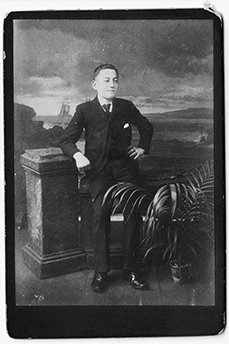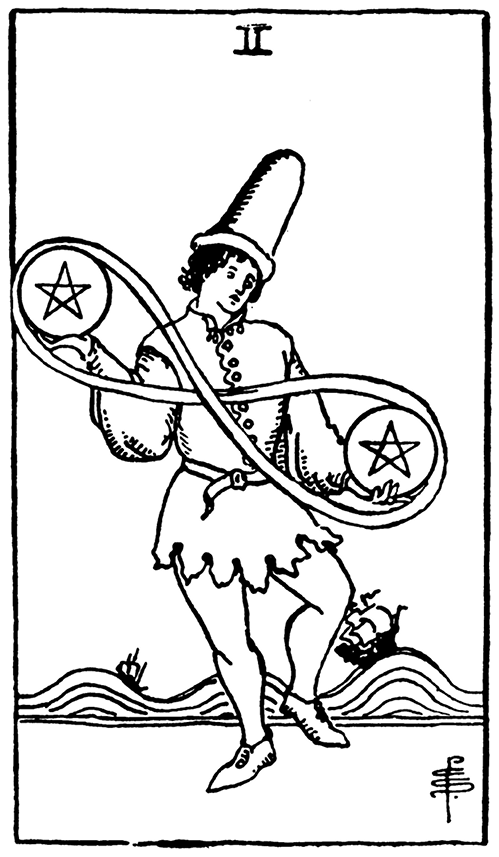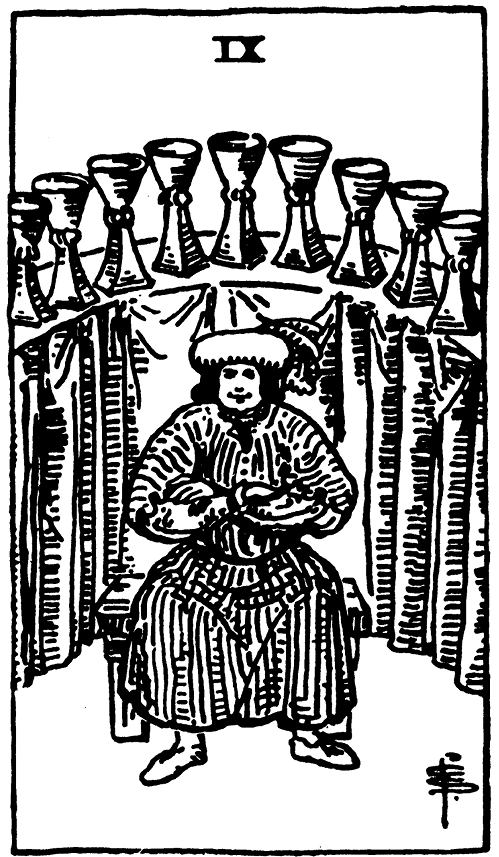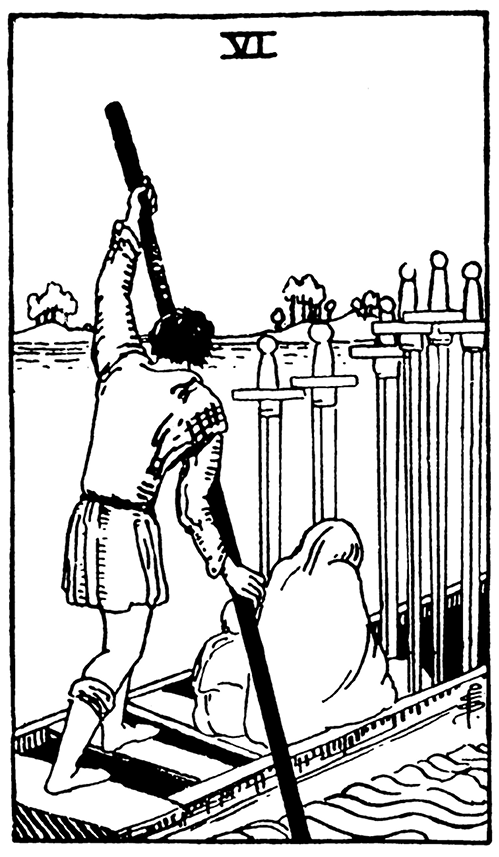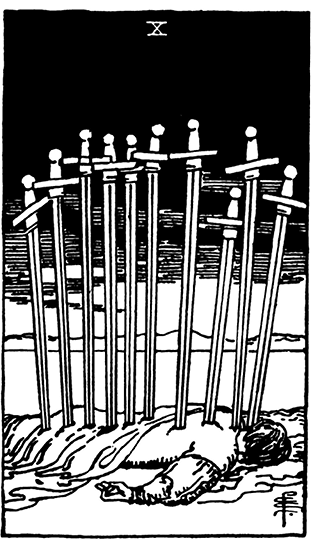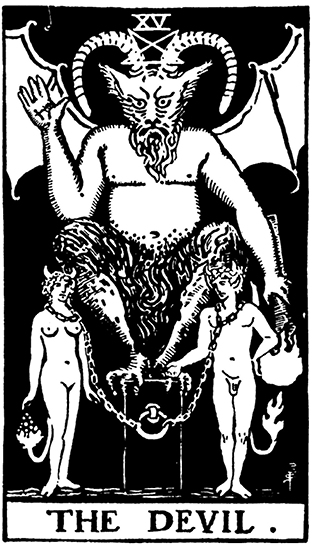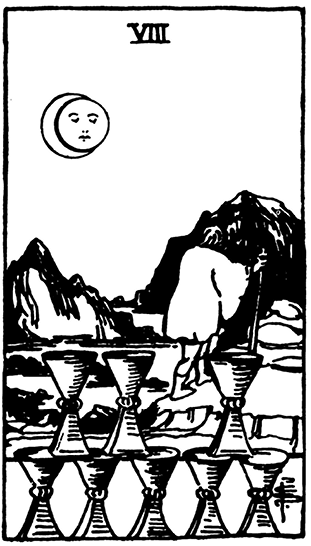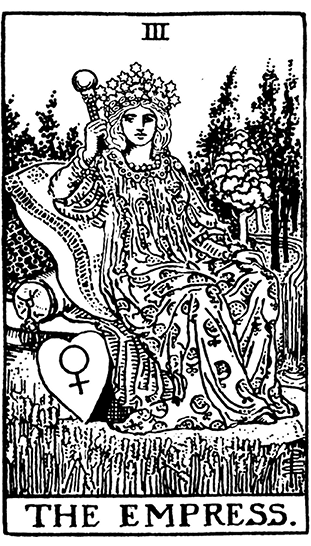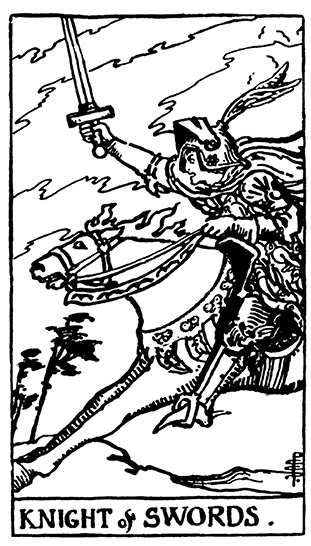Spreads & Reading Methods
… and now, he seeks in book and manuscript
What he shall never find.
–W. B. Yeats, “The Phases of the Moon” (1907)
The Pestle of the Moon:
Activating Your Intuition Through the Moon
In this tarot exercise, you will be guided through the eight phases of the moon to regenerate your intuitive abilities. This will be done in the spirit of Pamela, who herself became one with her creations, embodying the cliff face overlooking her own self-portrait drawn to Beethoven’s Piano Sonata no. 11, op. 22, and also bringing human form to the turbulent ocean through her anthropomorphism of waves in her painting The Wave (1903). We also see this “land becoming human” in her work Red Cloak (1906).152 Such embodiment of the landscape was intrinsic to Pamela’s work and here we use it to mystical device.
In working with the moon, we draw upon W. B. Yeats’s elaborate system of mysticism that he collected in A Vision (1907) and which contains a poem called “Phases of the Moon.”153 In this poem he provides attributions for the moon’s phases. In combining his poetic vision and Pamela’s notion of embodiment to music, we will access and inspire our own intuitive abilities.154
This is an entirely “off-book” method that may not even register consciously as to its effect. It should be practised for enjoyment and relaxation—a form of tarot meditation— without any specific result expected or sought.
This practice commences on the new moon and will last the duration of the twenty-eight-day lunar cycle. You should record your dreams during this practice, which can be one of the ways in which your intuition will express itself. After Yeats, we call our method (previously used only in private within a secret magical order) the “Pestle of the Moon.” It is based on Golden Dawn techniques, particularly those taught by Florence Farr in her “secret order within a secret order,” the Sphere Group.
The Pestle of the Moon
On the new moon, out of your tarot deck pick the High Priestess and the Moon cards. Place these cards vertically in the centre of a table, High Priestess above the Moon.
Shuffle your deck and take out eight cards at random.
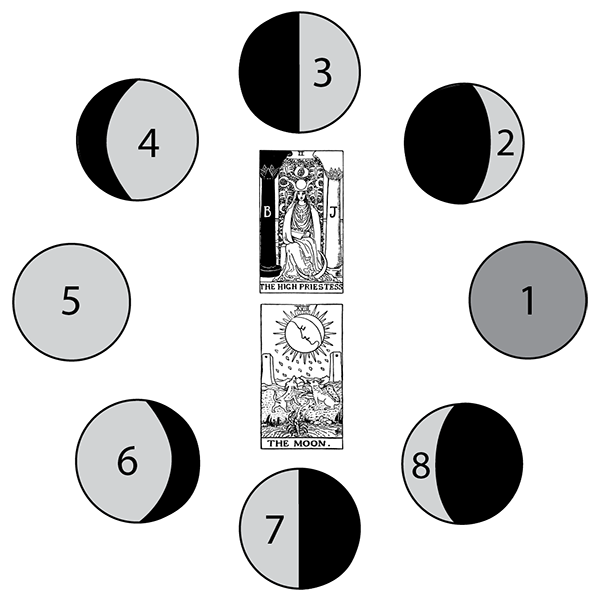
111. Pestle of the Moon Spread. Created by Llewellyn Art Department. Cards used reprinted with permission of U.S. Games Systems.
Starting from a “new moon” position at the right of the two central cards, arrange each of the eight cards in a circle. The positions and their key phrases are as follows:
- New Moon: The Cradle
- Waxing Crescent: The Dream
- First Quarter: The Whim (of Adventure)
- Waxing Gibbous: The Hero’s Crescent
- Full Moon: Twice Born, Twice Buried
- Waning Gibbous: The Soul at War (in Frenzy)
- Last Quarter: Tremble Into Stillness
- Waning Crescent: The Casting Out
Each of these phases lasts for about three days and nights, so we tend to work with each card for that length of time, using an online lunar calendar.155
- Take the card appropriate to the moon’s phase and set it by your bed.
- Glance at the card and allow your intuition to pick a particular feature or symbol.
- Close your eyes and imagine the card in your mind.
- Open your eyes and glance at the card again.
- Close your eyes and repeat several times until you can imagine most of the card.
- As you fall asleep, repeat the key phrase of the appropriate lunar phase, i.e., “Tremble Into Stillness,” whilst allowing the card image to become larger in your imagination.
- As the image surrounds you, imagine you are “losing your edges” and merging with the landscape and figures of the card. In modern terms, pixellate yourself into the image’s pixels.
- Imagine now that the phrase is turning into a sound, and the sound becomes music.
- Allow yourself to sink into the landscape of the card and the music as you sink into sleep.
- Repeat this for three nights, and then use the next card in the sequence.
After performing this exercise for all eight cards through a full lunar circle, note any dreams or feelings this exercise has evoked or any reactions you have to the cards or key phrases. You may feel like creating something such as a piece of writing or poetry. There is no particular outcome for this exercise; it is used to generate intuitive and instinctive emotional responses to the cards divined according to poetry.
Reading the Cabinet Cards
The creation of the Waite-Smith tarot was in part a collaborative effort, although one very different from that same effort undertaken by Frieda Harris and Aleister Crowley some years later in the design and execution of the Thoth tarot deck. In the latter case, it was a five-year project, and there are extant records of communication between the two. It shows clearly that Harris often felt that she was channelling the energies of the cards, and although some of her work did not meet Crowley’s approval and was redesigned, much of it was incorporated.
Similarly, Harris, as a student of Crowley’s work and other esoteric currents such as Theosophy, was able to work with Crowley in manifesting his vision. In the case of the Waite-Smith Tarot, it was a five-month project with little known communication between the two parties, the artist had little in-depth knowledge of the esoteric minutiae, and the designer had no time at all to request revisions before the deck went straight to print.
Pamela was unlike Frieda Harris in her design of the cards. She had no time (nor had been given enough income) to spend five years creating a masterpiece of projective geometry. In fact, as a trailblazer of “scenically illustrated Minors,” she did not even have the luxury of revising her work, so was not particularly consistent in her designs. There is no pattern, for example, that we can really discern, as to a key design feature; the “stage line” in some of the cards. In other cases, such as the kings all having thrones, etc., there is consistency of design.
We believe Pamela created the images on the cards as she saw them and did not constrain them by sticking to technicalities. The world she drew upon and projected was the world she knew best: theatre, drama, stage design, and costume.
Costume and Symbolism
The Lyceum Theatre was not just Edy Craig’s school—it was also Pamela’s. It was here that she would have learnt from Irving that every costume choice could serve to denote character. An example of this in the card imagery is the World, and the use of the scarf. Even such a simple item can carry dramatic weight; a scarf that Edy made under Irving’s tutorship for Shylock in a Merchant of Venice production was to be “a rich, flaunting scarf … a scarf covered with all my jewels … a touch of imagination all bright.” It was “thus Irving used costume as an element in the interpretation of a character, the smallest details symbolising the character’s outlooks and values.”156
The most consistent design ethos is that of the cabinet cards that were popular at the time Pamela was growing up in the theatrical world. These cards were in part a merchandise spin-off from the world of theatre, although everyday people also had their portraits taken in this style.
They depicted theatrical figures and got their name from the Victorian cabinets they would adorn. These cards became very popular in the 1860s and onwards until their decline in the 1890s. If we compare the general layout of a cabinet card to the Waite-Smith tarot cards, we can see that Pamela had returned to her roots in their composition.
The composition of the theatre cabinet cards consisted of the following components:
- Character and costume;
- Props (usually one significant prop to establish the scene);
- Backdrop/scenery (often including a wall or other divider to give a sense of perspective); and
- Dramatic scene or quote.
If we look at Pamela’s cards we can see how the images are composed in a similar way. Let us take as an example the 6 of Cups:
- Character(s): Three characters are depicted in the scene: two young people (male and female), and a man, exiting stage left.
- Prop(s): Six cups containing flowers, and perhaps the pike or spear the man is carrying.
- Backdrop/scenery: The courtyard of a country house and tower, with perspective being given by a stone stairway and plinth.
- Action: A soldier or watchman is walking away. One figure is giving the other flowers.
We can use these four components to read the card as Pamela constructed it—as a theatrical cabinet card. In this particular card, taking those four elements, we gain an overall theme of sentiment and affection, played out in the absence of a significant male figure. This provides an interesting reading of the card and one that may not have been obvious looking at it in other ways.
In reading a spread, we can separate and compare or contrast these four elements to gain unique and profound interpretations, as we are tapping into the “secret” construction of the cards. Here is a simple three-card spread with the positions past, present, and future, left to right.
We shuffle the deck and select three cards: 2 of Pentacles, 9 of Cups, 6 of Swords.
In no particular order of the four components, we first take a look at the backdrop element of the three cards, and see:
- A turbulent ocean.
- Nine cups on display.
- A shoreline.
We can then interpret these three different backgrounds as the background to the situation as it moved from the past into the present, and as it is likely to move into the future. It is like watching a three-act play with scene changes.
|
|
|
|
113. 2 of Pentacles, 9 of Cups, 6 of Swords. Reprinted with permission of U.S. Games Systems.
In this case, the backdrop elements show how the situation has progressed from a turbulent emotional state (1) to one with clearer boundaries (3)—due to exercising and displaying emotional restraint (2). The waves have been contained within the cups, leading to a destination that is more clearly defined.
We can then take a look at the props to see how this situation might come about:
- A mobius strip that contains the pentacles;
- A bench; and
- A boat and a pole.
Reading this in sequence, concentrating only on the props, we see that in the past was the 2 of Pentacles—juggling security and no progress. In the present is the 9 of Pentacles, where we have secured stability (the bench). In the future we see in the 6 of Swords a boat and a means of moving it, so the situation is likely to move on.
We can imagine this as having wheels but no transport, so stopping to rest on the bench, and then turning the bench into a boat and moving on. It tells us that the time for resting is over, and we have the resources now so there is no excuse to “spin our wheels” and we have to move on under our own direction.
We can now take a look at the characters in the three cards:
- A mercurial figure dancing and juggling. [False Mercury]
- A self-satisfied merchant character. [Falstaff]
- A man ferrying a woman and child.
We interpret these in more detail, especially if we now knew the question being asked was, for example, “After my recent divorce, should I be looking to date sooner or later?” In the first card, we see a false messenger, so that does not bode well for immediate dating, and the second character on the scene is also somewhat self-satisfied and complacent. In the third we see someone willing to take us places. So our overall reading is that after a false start and perhaps another person who may prove too self-centred, the querent will meet someone willing to invest in the relationship. However, it will certainly require distance to be travelled, from the third card.
And finally we turn our attention to the drama playing out in each scene to get an overall summary of the reading. We would expect this to match our reading of the other three components. Sometimes when reading in this way, we cast new light on the other elements when we read a particular element. The appearance of a particular prop in one card can give a new perspective to the characters’ motivations in the other cards, for example. This way of reading is of course similar to deconstructing your favourite TV series; when we see the glass eye throughout several episodes of Breaking Bad, for example, it is not until a scene later that we realise its source, which in turn comes from the interaction of the characters.
In these three cards, we could see the drama unfolding as follows:
- A ship battling the waves of a storm.
- A merchant displaying his products and showing his ownership.
- A family being transported to a better place.
These three scenes provide us a good summary of what has been discerned in the previous stages of the reading; the woman has come through an emotional storm but was not shipwrecked by it, and is now ready to start opening herself to others. This will result in her family being taken in a new direction so long as she keeps her boundaries—the “ownership” implied by the second card.
In considering the cards as cabinet cards, we are able to reverse-engineer the design principle that Pamela used in drafting these images so quickly, and from her existing knowledge and background. This allows us further to read the cards using the layers that Pamela provided us in their design.
A Note on Four Worlds: Advanced students or those readers familiar with our other works will be able to compare these four layers to the four worlds of interpretation in Kabbalah.
- Character(s): The world of Atziluth, the secret and core interpretation.
- Backdrop/scenery: The world of Briah, the extended interpretation of the card.
- Prop(s): The world of Yetzirah, the symbolic interpretation of the card.
- Action: The world of Assiah, the literal interpretation of the card.
Stage Directions
In this section, we will use the design of the cards as a collage to create theatrical scenes. We can perhaps imagine Pamela cutting out the figures of the cards and moving the characters around in a toy theatre—all the while telling us a story of their drama.
This ability to weave the cards together will help bring your readings to life. In fact, one of Waite’s colleagues, the author Charles Williams, wrote of such a living tarot deck in The Greater Trumps:
It was a table made of some sort of strange wood … upon that plate of gold were a number of little figures, each about three inches high, also of gold, it seemed, very wonderfully wrought … the figures might have seemed like those in a game; only there were many of them, and they were all in movement. Gently and continuously they went, immingling, unresting—as if to some complicated measure, and as if of their own volition … He saw among them those who bore the coins, and those who held swords or staffs or cups; and among those he searched for the shapes of the Greater Trumps, and one by one his eyes found them … 157
In the absence of a Star Wars-type holographic table on which our cards can mingle, let us imagine how we could create a stage version of several cards in a five-card reading. The more exaggerated you create this exercise, the more it will make your readings flexible in real life.
Let us consider how each card might contain elements of stage design and management, with a few rules:
- Any card with movement will carry an ENTER or EXIT stage direction.
- Any static character will contain a SCENE OPENS (or CHANGES) instruction.
- Any major card will bring LIGHTING and/or MUSIC & SOUND EFFECTS.
We will give as an example a five-card reading, with no fixed meanings for the positions for the cards:
10 of Swords, Devil (XV), 8 of Cups, Empress (III), Knight of Swords
|
|
|
|
|
|
114. 10 of Swords, Devil (XV), 8 of Cups, Empress (III), Knight of Swords.
Reprinted with permission of U.S. Games Systems.
Here is our interpretation using the cards as stage directions:
SCENE OPENS
(10 of Swords)
A murder has occurred. A man lies prone by the shoreline; ten swords spear him to the ground.
There is a BACKDROP of storm clouds.
[Devil] CUE DIRGE MUSIC. There is something sinister going on!
CUE LIGHTING. The stage lighting is dimmed.
CUE SPOTLIGHT. The Devil appears where he has been sat in the shadows with two consorts. He is crouched upon a plinth from where his two consorts are chained. A woman and a man, but they have faun-like horns and tails of grapes and flames.
ENTER STAGE LEFT: A cloaked man trudges onto the stage, staff in hand; he does not look back.
BACKDROP of mountains and sky out of darkness lit by appearing lunar eclipse.
The man walks by the corpse, seeming not to notice the Devil, and exits STAGE RIGHT.
CUE SCENE CHANGE.
BACKDROP: A cornfield, a beautiful, flaxen-haired young maiden bedecked with a crown of stars sits upon a throne where the Devil was previously sat.
CUE MUSIC: Debussy, Girl with the Flaxen Hair.
The man with staff walks into the scene, entering STAGE LEFT.
CUE SOUND EFFECT: Battle FANFARE.
ENTER STAGE RIGHT: A young knight riding a white steed arrives in fast flight. He brandishes a sword.
BACKDROP: Scudding white clouds.
When we create these directions as a journal exercise, in a group, or in our imagination, we gain insight into the cards and their dynamics. We also gain a sense of their action and influence upon each other and in our daily lives. Until we wrote this sketch, we were not aware of just how often the Devil card is already sitting in the background of a situation. When the card turns up in our future readings, we will be more aware that his influence is likely to already be present, although hidden in the shadows. Perhaps we will look for a spotlight card (the Sun, the lamp of the Hermit, etc.) in the reading to show how we can undercover his evil influence.
We can now add dialogue into the dramatic presentation as well as stage directions. We imagine that the young knight and the man with the staff will meet in front of the Empress. Let us imagine for a moment what they might say:
KNIGHT: I bring news, my lady, from the realms.
EMPRESS: Speak, O Knight.
KNIGHT: Much is changing, O Queen, and it is happening quickly.
MAN: I have walked from the coast and I have not seen these changes. All is as it ever was.
EMPRESS: Then I charge you to accompany my knight and be his eyes whilst he rides out. You will see what is changing in my realm and I will bestow my blessing upon you.
In this brief dialogue, we begin to see more deeply how the Empress card, a major, is naturally more powerful than the court cards or minors. Similarly, we see how the court cards act as the messengers in the deck, connecting events together—as people, aspects of oneself, or energies within a situation. We also see how two cards can work together to best advantage; the Knight card here provides more energy to the 8 of Cups, and the 8 of Cups can bring insight that the rapid Knight will miss in his travels.
If these cards came up in a reading, for example, about a potential move of house, we can now see that the Empress will provide protection to the move, assuring it goes smoothly. The Knight will bring changes, but must be balanced with the slower, more cautious, and pessimistic 8 of Cups. It could be summed up as “plan for the best but prepare for the worst” to achieve your goal.
Summary
The Waite-Smith deck was conceived as a kaleidoscopic theatre set with characters, scenes, and events that could be arranged in almost infinite variation.158 In playing with the deck as a dramatic device, we tap into this intention and not only bring the cards to life, but also invigorate daily life, where we are all “actors on a stage.”
Stagecraft: Bringing the Cards to Life
In this exercise, we will take advantage of the cards as set designs and dramatic scenes. This is good to do as an individual and great fun as a group game. Whilst the Waite-Smith cards were originally designed with the theatre as the dramatic venue of the time, we have updated it to the cinema and movies with contemporary genres.
Solo Version: Scriptwriting
Separate the cards into three piles: sixteen court cards, twenty-two majors, and forty minors. Select one to four court cards (start with one as a beginner) for your characters. Consider how these characters might act, what their motivations might be in a scene. Then select one minor card to suggest a scenario. For example, for the 4 of Swords, the scenario or situation could be a rehab facility; another example would be the 8 of Wands—suggesting a flight movie, either literally as a movie about airplanes or symbolically as a prison break/escape.
Once you have selected the situation, this may also suggest good names for your court cards. If the Queen of Pentacles was our single character, and we pulled the 8 of Wands for our scenario, she could be “Margo Harris,” a motherly flight attendant aboard Flight 888.
Draw a major card for the script’s theme. If it was the Tower, of course it would be an airplane disaster movie, although the Star card would make Flight 888 a futuristic flight; perhaps Margo is onboard the world’s first commercial flight to another planet!
Write a few lines of a screenplay using these components. If you wish, you can include a few stage directions or set descriptions.159
FLIGHT 888
Act I
FADE IN
INT. GALLEY CABIN OF THE STARSHIP
A perfectly white room with various panels and buttons, each with an icon for food or water. We PUSH IN to the door, which slides up and
CUT to:
INT. LIFEPOD HALL—CONTINUOUS ACTION
A long hallway in which a hundred lifepods are laid out in rows. A uniformed woman, MARGO, is sat on a control chair. She looks down at her feet where we see a rabbit, BLINKY.
MARGO
(to BLINKY)
I know, I know. You shouldn’t be out. But it isn’t like you are going to escape, is it? We’re all in this hutch together.
(sings slowly and tunelessly)
“When you wish upon a star, you can go very far.” Or something like that. OK, Blinky, it’s feeding time. Let’s get everyone looked after, shall we?
In scripting such scenes and dialogue, we can deepen our appreciation for the cards as characters and scenes in narratives. Here we see that the Queen of Pentacles is not really invested in the vision of the Star card, but it is essential to ensure that we get to reach our vision in good health. The combination of the Queen of Pentacles and the Star card in a reading, particularly if the Tower appears (as it will do in our script above when the Starship galley explodes!), would indicate the need for self-care when working towards a goal, particularly to prepare for any sudden shocks in the project.
When we take the cards into unusual combinations, we practice being able to answer any question given to us as a reader, and to see the flexibility of the cards to provide a representation of any scenario, no matter how unusual or unique.
Group Version: Whose Line Is It?
To play this as a group, you’ll need two to four volunteers to choose a court card and an adjudicator who will select a minor arcana card for the situation.160 The adjudicator should endeavour to make the scene as amusing or extreme as possible; the 4 of Wands should be the biggest party on the planet, or a backstage pass to an Abba reunion concert (with bonus points for sneaking in Abba song quotes).
Allow time for the court cards to get into role, and select a major card for the first style (see following list). So we pull the Strength card—a martial arts style movie. This can involve the characters talking in “pretend dubbing” or on a secret mission, backstage at the Abba concert.
Then give them the scene and theme and a few minutes to act it out.
As the scene progresses, select another major card and change the style. The characters get bonus points if they transition smoothly into the next style without breaking their plot, dialogue, or action. So suddenly the martial arts movie may turn into a sensual movie, just as our characters meet Abba …
Here is another example. We sometimes give our players a prop such as a cup, a few toy swords, coins and sticks to add to the fun.
On the Beach
Court cards: Page of Cups and Queen of Swords
Situation card: 8 of Swords
Theme/Style card: The Hermit
This is a nice straightforward example; we have a beach scene with constraints and a survival theme. Surely our two characters are shipwrecked.
The two players told us they were on a deserted beach. A storm is in the distance. Debris is strewn across the shoreline. They described themselves as Mrs. Smith, a sharp-looking woman, dressed in what remains of business attire. The player acting as the Page of Cups held a cup and described himself as Tad, a bedraggled youth.
The adjudicator had already given them the style of a survival film and they started acting out a walk along the beach.
MRS. SMITH: Are you going to carry that all day?
TAD: [Turns beaker upside down, making the sound of pouring out seawater and pretends that a fish has fallen out. He lifts it up and waggles the imaginary fish.] Damn, I’d grown close to Roger.
The Adjudicator pulls the Empress card and immediately changes the style by yelling “Nature Documentary!”
TAD: [Holds up imaginary fish to group]
MRS. SMITH: [Adopts David Attenborough nature documentary voice] And here we see the Roger Fish, a shy retiring creature that only lives in cups. However, it has a unique survival instinct and when removed from its cuppy home, plays dead for a moment only to suddenly grow to the size of a small whale in a matter of moments. Let’s see, shall we?
TAD: [Starts to mime the fish growing to the size of a whale and it being on top of him]
… and so on.
We have a lot of fun with these games, and whilst they offer amusement they can sometimes teach us more than we think. When we consider the Queen of Swords and the Page of Cups in combination with the Hermit and the Empress, we get a sense of that dynamic in this game.
The Page of Cups can let the surprises of his own emotional world overwhelm him when he tries to be more like the Queen of Swords, and intellectually superior. We cannot be a hermit to our own nature—the Empress. Otherwise we will find ourselves as “fish out of water” inside our own selves, which may overwhelm us.
These games teach us more in experience than we can often explain verbally.
The Dramatic Styles of the Majors
- The Fool: Comedy/Slapstick
- The Magician: Reality show
- The High Priestess: Mystery, whodunnit
- The Empress: Nature documentary
- The Emperor: War film
- The Hierophant: Biblical epic
- The Lovers: Tear-jerker
- The Chariot: Car heist/Racetrack
- Strength: Circus/martial arts
- The Hermit: Survival
- Wheel of Fortune: Gambling/casino
- Justice: Courtroom drama
- The Hanged Man: Betrayal/Revenge
- Death: Ghost/Zombie
- Temperance: Diplomacy
- The Devil: Sensual
- The Tower: Disaster
- The Star: Science fiction
- The Moon: Dream or psychological horror, black comedy
- The Sun: Coming of Age/Teen
- Judgement: End of the world/Apocalypse
- The World: Travel/Foreign movie
Reading the Play
As we have seen, Pamela’s design took inspiration from the Sola Busca deck. There are nine cards in particular that are direct inspirations for their Waite-Smith equivalent; however Pamela translated this source through her theatrical perspective. In effect, she took the myth and movement of the Sola Busca and found corresponding stories, scenes, and narratives to represent them.
We can use this in our readings by paying particular attention to the body language of the figures and interpret them not as characters in themselves but as actors portraying roles. It was said of William Gillette that he could convey intensely complex feelings by even his stance and silence.
If we take a look at the 7 of Swords in the original Sola Busca image, we see a young male figure, naked apart from a wreath crown upon his head, in the act of stepping over a round Roman shield known as a “parma,” which is emblazoned with the initials S. P. Q. R. In doing so, he appears to straddle three swords, and clasps one firmly in his hands. On his back are three swords held upright by a bag. Giordano Berti says of this card:
Leapfrog a shield with arms in hand: A landslide win can bring misfortune, Boast. Useless and dangerous challenge. Damage to one’s image.
We see clouds in the backdrop of the card.
If we then look at how Waite describes this image in PKT, he says that it shows “a man in the act of carrying away five swords rapidly: the two others of the card remain stuck in the ground.” He then tells us that the design is uncertain in its import, because the significations are widely at variance with each other (PKT, 240).
We should then consider this body posture, how the actor—if this were a play—would be using this posture and movement to quickly convey suspicious activity, stealth, secrecy, and many other emotions. We can then bring these emotions to our reading for deeper readings.
Let’s take this approach to a simple three-card reading and lay out three cards:
- What not to do
- The middle path
- What to do
Card one: What not to do, 8 of Pentacles
Do not have too much focus, commitment, and pride in work. This may seem odd advice and against common sense. So let us take a look at what we should do.
Card three: What to do, 2 of Cups
Here we have two actors we can either read together or choose one as the protagonist. You can do this by asking yourself which character you most identify with. If the answer was the male character, describe his actions and body language, and you may see that his stance is one of extending himself forward, one foot placed in front of the other; it is not a sturdy position and is somewhat dainty in appearance. He holds the Cup with his left hand and reaches out with his right to touch the other cup. These actions of the actor in the card gives the impression to the audience of a man who has a strong female nature, not overtly masculine. We could read this as an act of giving or exchange.
This now makes sense of the “what not to do” advice of the 8 of Pentacles—we should not become too wrapped up in work life at the expense of our relationships.
Card two: The middle path, the Emperor.
Here we have an actor who is in character of a mature leader. The look on his face is confident but severe. However, his gaze is slightly to the left, which could imply that he is not giving you his undivided attention, as he has his whole empire to consider. His posture is very upright and firmly fixed, and he is positioned in a very symmetrical way. He holds props that denote his elevated status.
In the advice given in relation to the middle path, this could recommend maintaining a state of self in relating to others; you can be of service to others but still maintain the upper hand and be in charge of your own affairs. It also counsels thinking of the bigger picture, not being lost in our work—the warning of the 8 of Pentacles.
Quick Reading Practice: Yes/No Answers
To practice using the Waite-Smith cards (or any other deck), you can use these two quick spreads taken from Minetta, writing in 1896, slightly ahead of the Waite-Smith tarot.161 They are both designed to determine a simple yes/no answer, so you may like to test them out.
A note on significator cards: In many readings, particularly older cartomantic methods, a card is selected in advance to stand for the querent. This is the significator card. There are many various methods of selecting a significator, based on appearance of the person, gender, age, astrological considerations, or numerology of their name, etc. In this method, we adopt Waite’s own suggestion, that you simply pick a Queen or King card as you please.162
Another Way of Having a Wish
Place a card for your significator on the table. Shuffle the cards and wish. Draw five cards, placing the first face down at the head of your significator, the second at the feet, the third on the right, the fourth on the left, and the fifth on the card representing yourself.
If the 9 of Cups is one of the five, you will obtain your wish; if, however the 9 of Pentacles is drawn, you will not have your wish. This can be done three times, but it is very much luckier if the wish card is drawn the first time.
By Fifteen
Shuffle your cards, having placed the significator on the table. Take three cards from the top of the pack; place them at the head for luck, three at the feet for the past, three on the right for the future, three on the left for the obstacles, and three on yourself for what is immediately crossing your path. It is a lucky omen if the 9 of Cups or the Ace of Swords, right way up, crowns your significator.
Past, Present, and Future Spread
Place a significator card that you feel represents you or your querent face up on the table. Then shuffle the remaining cards in the deck and divide into three piles, face upwards. Then interpret the top three facing cards. Take the remaining cards and draw two cards placing them face down upon the significator card. Next place a card above the significator card and one beneath, then to the right and left, as to form a cross layout. Then put a card at an angle to the right of the top card, and then continue to place the cards down in this order until you have used up all of the cards remaining. All being well, there will be five cards at the top arm of the cross, ten on the significator, and four each on the other arms of the cross.
What the positions of these cards in the spread tell you about the timings of the reading.
The five cards over the querent card of the reading tells us that something is going to occur of significance imminently.
The four cards on each of the piles to the right of the querent show events and conditions in the near future. The four cards on the left of the querent speak of past events. The four cards at the base indicate plans and obstacles to the situation.
The Four Fans
A quick way of reading the cards
First the querent shuffles the deck well and then hands the tarot cards to the reader, who spreads them face down on the table. The reader then asks the querent to draw eight cards intuitively and give them to him/her to spread out into the shape of a fan. This process is followed three more times, until we have four fan-shaped spreads.
Fan 1: That you will gain
Fan 2: That you will lose
Fan 3: That you may have
Fan 4: That you would choose
Read the sequence of cards as the storyboard of a play or film as we have covered in this book.
The Celtic Cross Revisited
In this section, we will conclude by seeing how this new information on the Waite-Smith deck informs a Celtic Cross reading.
- Influence: Five of Pentacles
In PKT, Waite describes the 5 of Pentacles as “two mendicants in a snow storm pass a lighted casement.” Taking this further and being fully aware that “mendicants” are not entirely helpless beggars who have no control over their lives—that it is a spiritual lifestyle choice—this card is now given more of a positive take. Therefore the 5 of Pentacles in the “influence” position of the reading informs the reader that the querent is in control. They have sacrificed material advantage to gain a spiritual one. This card can also indicate the temporary deferral of material reward, for example taking on a program of study, volunteer work, savings, or long-term investments.
- Obstacles: Temperance
In the obstacle position of the Celtic Cross, we have Temperance. Our new perspective puts emphasis on the presence of Iris, the messenger of the gods. The obstacle therefore in this reading is disappointment in others. It is a card of seeking contentment in oneself; this person has given to others, in an unbalanced way. Waite says that “if the card in this position is positive, then the obstacle is lesser and can be overcome.”
- Aim: 2 of Pentacles
This is the position to which the querent must aim. This card cautions against being tricked by “false Mercury” and aiming to see what the situation truly is, not the false hopes presented by another.
- Resources: The Fool
This position of Resources in the Celtic Cross informs us of the resources and qualities that the querent possesses to take them forward into life. It is what guides the Fool along the way; it is total belief in the now, the belief in the guidance of a greater Creator power. As Waite says, “The sun, which shines behind him, knows whence he came, whither he is going, and how he will return by another path after many days” (PKT, 153). It is the “all-seeing eye” that looks over everything; it is godlike in nature. It is effectively saying have faith in the process and all will be well.
- Recent Past: 9 of Cups
The 9 of Cups in the position of the Recent Past, when taken into account his identity as Falstaff, is not merely a self-satisfied lover of life and all things indulgent. He has a propensity to be untrustworthy. He is also a bit of a Terminator-like character, in that when you think he is finished off, and out of your life, he suddenly comes back to life and claims the honour of the day. Falstaff in character in Henry IV pretended to fall down dead and then arose, to claim a deed that was not his own. Never trust a man who possesses too many trophies. If you have anything of value, then nail it down, as this person will take it! This position speaks of trusting somebody too easily in the past, and being let down; this could result in losing faith.
- Near Future: 5 of Wands
This is a card in which Pamela shows us that sometimes the task itself is as much to be enjoyed as the accomplishment. So in this position of the Celtic Cross, the querent needs to foster this attitude in order to move forward into the future happily.
- Self-image: 9 of Pentacles
In this position of the Celtic Cross, this is how we see ourselves, or how the querent sees themselves. This interpretation, from a Pamela perspective, makes much more sense, in that the 9 of Pentacles speaks of Shakespeare and Rosalind from As You Like it. It is here that Rosalind professed that it is better marry a snail than a man. This advises working upon your own self-sufficiency and that will shelter you from the external world.
- Appearance: 7 of Swords
In this position in the Celtic Cross is the outward appearance we or the querent gives to the world; it is the mask we wear to get through social engagement. The 7 of Swords tells us that other people are observing that time itself is sneaking around you unawares. They see what you do not—that time is slipping away from you. It could be that we give off an air of not taking responsibilities too seriously, but that this is an act put on to appear in charge.
- Concerns: 7 of Wands
In this position in the Celtic Cross, it draws attention to a perception of bullying and belittling, by words alone. As we have seen, the nature of Petruchio in the play is one of a callous character who seeks to control someone for their own sense of worth. When this card is appearing in the Concerns position, it shows that there is a recognition this could be the case in the querent’s life.
- Summary: 3 of Cups
The 3 of Cups from Pamela’s perspective is about sisterhood and joining together to make a pledge to fulfil activities that mean so much to you. This could be to fight for social injustice and to dedicate yourself to spending your life being true to your ideals and values. The celebration of the triad “liberty, equality, fraternity.”
